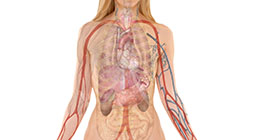Overview
Symptoms
Causes
Prescription
Health Tips
Stretch marks are scars that develop during a period of sudden, rapid growth or weight gain, which causes the skin to stretch and become thin. This compromises the integrity of collagen and elastin fibres in the middle layer of skin. When stretch marks first appear they tend to be a shade of purple or red due to the blood vessels becoming visible through the tears. Eventually the blood vessels will shrink, and the colour of the stretch marks will fade.
These wriggly-looking marks develop around the hips, belly, back, breasts, thighs, arms and on the insides of the knees. Pregnant women, adolescents and people who gain weight will often develop stretch marks. While women are more likely to experience them, they also affect teenage boys, male weightlifters, and overweight men.
Symptoms
The appearance of stretch marks varies greatly depending on severity, how long a person has had them, the location on the body, and a person’s skin type and colour. The colour changes of stretch marks tend to fade overtime. Stretch marks are:
- Faded lines that are silver or white in colour and do not tan
- Indented, stretched lines in the skin that vary in depth and width
- Lines that are purple, blue, reddish brown, pink or red in colour
Causes
Elevated levels of glucocorticoids, steroid hormones produced by the adrenal glands during pregnancy, adolescent growth spurts, rapid muscle growth or weight gain have been implicated. Corticosteroid creams break down collagen in the skin over a prolonged period of time and may cause stretch marks. Genetics, age and poor diet are also contributing factors. Stretch marks are a possible symptom in those with Cushing’s syndrome or Marfan syndrome.
Prescription for Health
The scarring due to stretch marks is a very stubborn cosmetic condition to treat. Prevention of stretch marks through proper nutrition and weight management is best.
| Nutrient | Dosage | Action |
|---|---|---|
| Choline-stabilized orthosilicic acid | 10 drops daily in juice; each drop contains: Silicic acid 1 mg | Important for building and retaining a healthy skin matrix. Silicic acid and biotin help build collagen. |
| Borage Oil | Adults: 4-6 tsp per day; children; 1-2 tsp daily
Each tsp contains 500 mg of GLA |
Reduces inflammation in the skin; improves moisture retention. |
| Sulforaphane | Apply topically | Repairs skin damage; restores and maintains skin integrity. |
Health Tips to Enhance Healing
- During pregnancy, many women have reported success with anti-stretch oils, lotions and creams that contain moisturizing ingredients such as, vitamin E, rosehip oil, cocoa butter, shea butter, avocado butter or olive oil.
- One can obtain a 30 to 50 percent improvement with radiofrequency tissue heating using devices such as Thermage® or Accent® RF. This modality is often combined with fractional resurfacing, which make tiny perforations in the skin resulting in new collagen formation by the body’s natural healing processes.
- Rapid weight gain and loss cycles are the biggest contributors to stretch marks. If weight fluctuates considerably, consult a naturopathic doctor or a qualified health professional for guidance in weight management.











